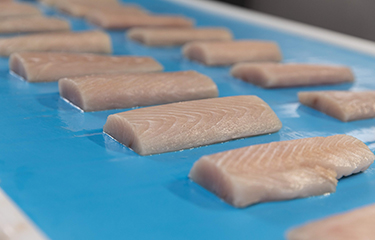For seafood processors, listeria prevention depends on a “culture of caring”
Sponsored

Commercial Food Sanitation (CFS) Founder and Senior Advisor Joe Stout knows how prevalent and dangerous Listeria monocytogenes can be for seafood processing facilities.
“Every night, there’s an army of bacteria that want to come into your plant, and probably do,” according to Stout.
When the enemy is as undetectable, adept, and difficult to eliminate as listeria is, manufacturers of every fishery subspecies have to be on top of their game, Stout said, which involves not only knowing how the bacteria operates, but also making sure the proper processing tools are in place.
“It’s hard to be perfect and on your game every day to keep consumers safe. But that’s what it takes to fight an organism like Listeria that can hide and multiply in seafood processing plants worldwide. From the time your product is fished out of the water, it’s met with a series of conditions that prompt Listeria to grow,” Intralox, a global conveyance solutions provider and the parent company of CFS, told SeafoodSource.
Intralox’s innovations cover many parts of the seafood-processing paradigm, including receiving, processing, freezing, packaging, and more. The company said it works to help processors protect against listeria, pathogens, and foreign material contamination risks with its conveyor belts and solutions. Safeguarding food safety and product quality, eliminating unscheduled downtime from belt or conveyor failure, and optimizing seafood plants’ throughput and reliability are also core to the Intralox mission, the firm said.
When it comes to Listeria growth specifically, factors to consider include harvesting, moisture, and temperature, Intralox said.
“Once caught, your product may be collected into bins with other fish or pushed around with shovels on the boat. If proper sanitation is lacking on the vessel, cross-contamination can occur,” CFS noted. “Bacteria do very well in wet conditions. And there is an ample supply of water in a seafood plant.”
While seafood processing facilities' low temperatures serve to stifle some bacteria, such as Salmonella and E. coli, Listeria can thrive in cold conditions, according to Intralox and Stout.
“In fact, few organisms compete well with Listeria in cold to freezing environments,” Stout said.
A number of cross-contamination sources exist in a seafood processing plant, Stout said, from fabric belts and closed hinges to sandwich joints and hollow rollers.
“For example, if your equipment has sharp corners where chemicals and employees can’t reach (commonly known as hard-to-reach, or HTR, areas), it could be a point of contamination where a colony harbor and grow,” he said.
Opting for conveyors, belts, and other equipment designed with hygienic principles in mind gives seafood processors more open, nonporous machinery with fewer niches for Listeria to colonize, Intralox Global Seafood Segment Leader Martim Piccoli said.
Stout and Intralox urged seafood plant operators to implement routine and rigorous environmental monitoring protocols to ensure food safety.
“While you may be able to observe your plant’s conditions, you can’t see bacteria. You wouldn’t be able to see a million of them. If Listeria is present in your facility, you must locate it. That’s what makes environmental monitoring so critical,” Intralox said.
It’s the plants that swab aggressively that will find the organism, Stout added.
“I like to say you have to ‘swab with authority’ so that you get to know as much about your environment as possible,” he said.
When it comes to sanitation strategies, it’s imperative to determine the best sequence for cleaning an area to prevent re-cleans and cross-contamination risk, Intralox said. It’s also critical to provide the processing team with the tools needed to clean better and faster, the firm noted.
“To manage the niche points of legacy equipment, we recommend establishing a periodic frequency to perform disassembly and deep cleaning. This will help you reach areas where colonies of listeria can be protected from the normal cleaning process,” the company said.
While “hiring labor is seen as an alternative to investing in technology that will automate plant processes,” according to Piccoli, the right automation equipment can add value (such as increased throughput), as well as remove hazards, including opportunities for cross-contamination.
“Automation reduces the risk of cross-contamination caused by personnel not precisely following Good Manufacturing Practices (GMPs),” Stout explained, adding that “plant personnel can spread bacteria by performing unclean actions, such as picking something up off the floor and going right back to touching the product.”
Ultimately, seafood processors need a team approach to get the upper hand with Listeria, Stout said.
“No one person or single team can be expected to do it alone. You may have heard the term ‘culture of food safety’ before. What does that mean? Your plant should have effective programs in place that are executed well so it’s routinely producing safe food,” Stout said. “I like to call it a culture of caring. Everyone in the plant is engaged and cares about doing the right thing to produce safe food.”









